Aibek Alanov
RiemannLoRA: A Unified Riemannian Framework for Ambiguity-Free LoRA Optimization
Jul 16, 2025
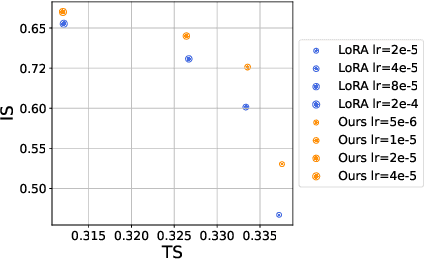
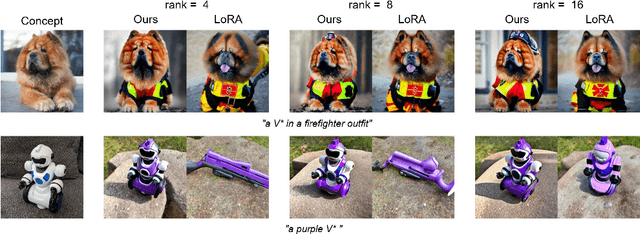

Abstract:Low-Rank Adaptation (LoRA) has become a widely adopted standard for parameter-efficient fine-tuning of large language models (LLMs), significantly reducing memory and computational demands. However, challenges remain, including finding optimal initialization strategies or mitigating overparametrization in low-rank matrix factorization. In this work, we propose a novel approach that addresses both of the challenges simultaneously within a unified framework. Our method treats a set of fixed-rank LoRA matrices as a smooth manifold. Considering adapters as elements on this manifold removes overparametrization, while determining the direction of the fastest loss decrease along the manifold provides initialization. Special care is taken to obtain numerically stable and computationally efficient implementation of our method, using best practices from numerical linear algebra and Riemannian optimization. Experimental results on LLM and diffusion model architectures demonstrate that RiemannLoRA consistently improves both convergence speed and final performance over standard LoRA and its state-of-the-art modifications.
Heeding the Inner Voice: Aligning ControlNet Training via Intermediate Features Feedback
Jul 03, 2025Abstract:Despite significant progress in text-to-image diffusion models, achieving precise spatial control over generated outputs remains challenging. ControlNet addresses this by introducing an auxiliary conditioning module, while ControlNet++ further refines alignment through a cycle consistency loss applied only to the final denoising steps. However, this approach neglects intermediate generation stages, limiting its effectiveness. We propose InnerControl, a training strategy that enforces spatial consistency across all diffusion steps. Our method trains lightweight convolutional probes to reconstruct input control signals (e.g., edges, depth) from intermediate UNet features at every denoising step. These probes efficiently extract signals even from highly noisy latents, enabling pseudo ground truth controls for training. By minimizing the discrepancy between predicted and target conditions throughout the entire diffusion process, our alignment loss improves both control fidelity and generation quality. Combined with established techniques like ControlNet++, InnerControl achieves state-of-the-art performance across diverse conditioning methods (e.g., edges, depth).
Inverse-and-Edit: Effective and Fast Image Editing by Cycle Consistency Models
Jun 23, 2025Abstract:Recent advances in image editing with diffusion models have achieved impressive results, offering fine-grained control over the generation process. However, these methods are computationally intensive because of their iterative nature. While distilled diffusion models enable faster inference, their editing capabilities remain limited, primarily because of poor inversion quality. High-fidelity inversion and reconstruction are essential for precise image editing, as they preserve the structural and semantic integrity of the source image. In this work, we propose a novel framework that enhances image inversion using consistency models, enabling high-quality editing in just four steps. Our method introduces a cycle-consistency optimization strategy that significantly improves reconstruction accuracy and enables a controllable trade-off between editability and content preservation. We achieve state-of-the-art performance across various image editing tasks and datasets, demonstrating that our method matches or surpasses full-step diffusion models while being substantially more efficient. The code of our method is available on GitHub at https://github.com/ControlGenAI/Inverse-and-Edit.
ImageReFL: Balancing Quality and Diversity in Human-Aligned Diffusion Models
May 28, 2025Abstract:Recent advances in diffusion models have led to impressive image generation capabilities, but aligning these models with human preferences remains challenging. Reward-based fine-tuning using models trained on human feedback improves alignment but often harms diversity, producing less varied outputs. In this work, we address this trade-off with two contributions. First, we introduce \textit{combined generation}, a novel sampling strategy that applies a reward-tuned diffusion model only in the later stages of the generation process, while preserving the base model for earlier steps. This approach mitigates early-stage overfitting and helps retain global structure and diversity. Second, we propose \textit{ImageReFL}, a fine-tuning method that improves image diversity with minimal loss in quality by training on real images and incorporating multiple regularizers, including diffusion and ReFL losses. Our approach outperforms conventional reward tuning methods on standard quality and diversity metrics. A user study further confirms that our method better balances human preference alignment and visual diversity. The source code can be found at https://github.com/ControlGenAI/ImageReFL .
FastFace: Tuning Identity Preservation in Distilled Diffusion via Guidance and Attention
May 28, 2025Abstract:In latest years plethora of identity-preserving adapters for a personalized generation with diffusion models have been released. Their main disadvantage is that they are dominantly trained jointly with base diffusion models, which suffer from slow multi-step inference. This work aims to tackle the challenge of training-free adaptation of pretrained ID-adapters to diffusion models accelerated via distillation - through careful re-design of classifier-free guidance for few-step stylistic generation and attention manipulation mechanisms in decoupled blocks to improve identity similarity and fidelity, we propose universal FastFace framework. Additionally, we develop a disentangled public evaluation protocol for id-preserving adapters.
DreamBoothDPO: Improving Personalized Generation using Direct Preference Optimization
May 27, 2025Abstract:Personalized diffusion models have shown remarkable success in Text-to-Image (T2I) generation by enabling the injection of user-defined concepts into diverse contexts. However, balancing concept fidelity with contextual alignment remains a challenging open problem. In this work, we propose an RL-based approach that leverages the diverse outputs of T2I models to address this issue. Our method eliminates the need for human-annotated scores by generating a synthetic paired dataset for DPO-like training using external quality metrics. These better-worse pairs are specifically constructed to improve both concept fidelity and prompt adherence. Moreover, our approach supports flexible adjustment of the trade-off between image fidelity and textual alignment. Through multi-step training, our approach outperforms a naive baseline in convergence speed and output quality. We conduct extensive qualitative and quantitative analysis, demonstrating the effectiveness of our method across various architectures and fine-tuning techniques. The source code can be found at https://github.com/ControlGenAI/DreamBoothDPO.
MaterialFusion: High-Quality, Zero-Shot, and Controllable Material Transfer with Diffusion Models
Feb 10, 2025Abstract:Manipulating the material appearance of objects in images is critical for applications like augmented reality, virtual prototyping, and digital content creation. We present MaterialFusion, a novel framework for high-quality material transfer that allows users to adjust the degree of material application, achieving an optimal balance between new material properties and the object's original features. MaterialFusion seamlessly integrates the modified object into the scene by maintaining background consistency and mitigating boundary artifacts. To thoroughly evaluate our approach, we have compiled a dataset of real-world material transfer examples and conducted complex comparative analyses. Through comprehensive quantitative evaluations and user studies, we demonstrate that MaterialFusion significantly outperforms existing methods in terms of quality, user control, and background preservation. Code is available at https://github.com/kzGarifullin/MaterialFusion.
Beyond Fine-Tuning: A Systematic Study of Sampling Techniques in Personalized Image Generation
Feb 09, 2025



Abstract:Personalized text-to-image generation aims to create images tailored to user-defined concepts and textual descriptions. Balancing the fidelity of the learned concept with its ability for generation in various contexts presents a significant challenge. Existing methods often address this through diverse fine-tuning parameterizations and improved sampling strategies that integrate superclass trajectories during the diffusion process. While improved sampling offers a cost-effective, training-free solution for enhancing fine-tuned models, systematic analyses of these methods remain limited. Current approaches typically tie sampling strategies with fixed fine-tuning configurations, making it difficult to isolate their impact on generation outcomes. To address this issue, we systematically analyze sampling strategies beyond fine-tuning, exploring the impact of concept and superclass trajectories on the results. Building on this analysis, we propose a decision framework evaluating text alignment, computational constraints, and fidelity objectives to guide strategy selection. It integrates with diverse architectures and training approaches, systematically optimizing concept preservation, prompt adherence, and resource efficiency. The source code can be found at https://github.com/ControlGenAI/PersonGenSampler.
CLEAR: Character Unlearning in Textual and Visual Modalities
Oct 23, 2024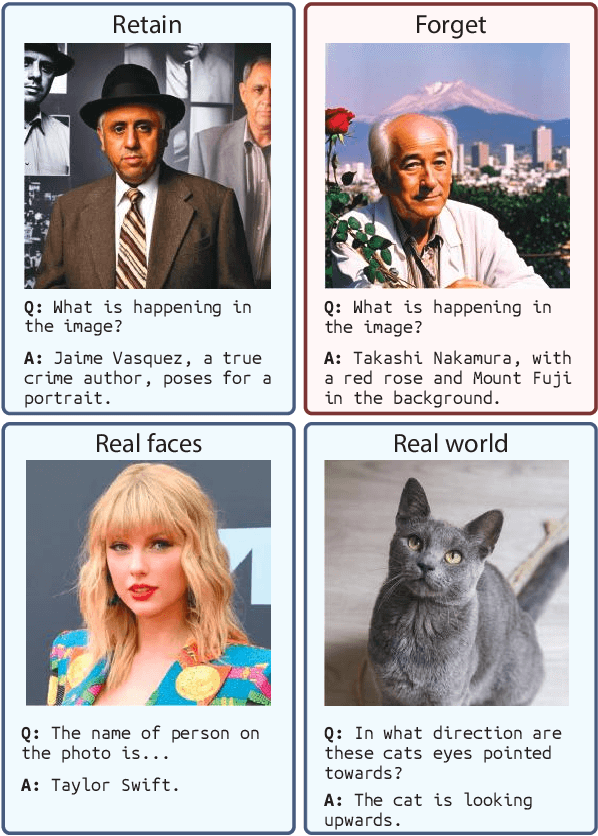
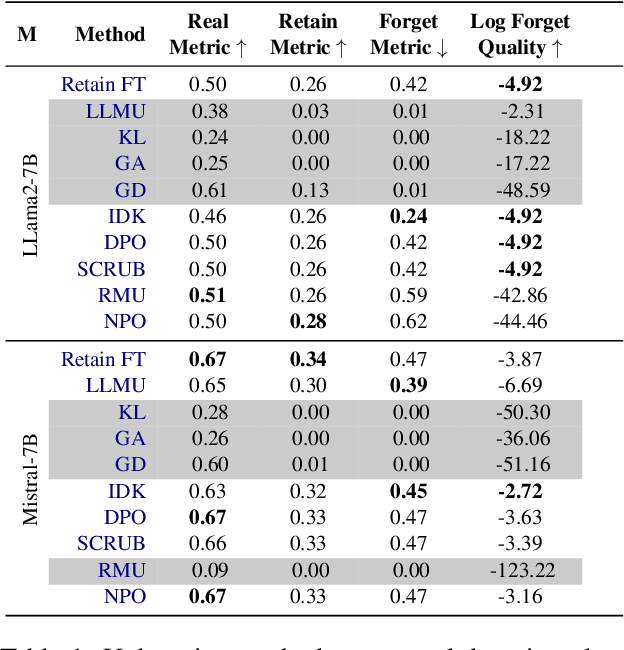
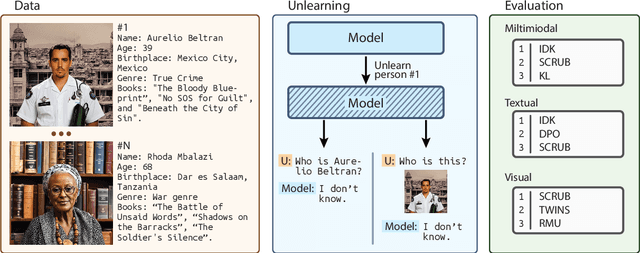
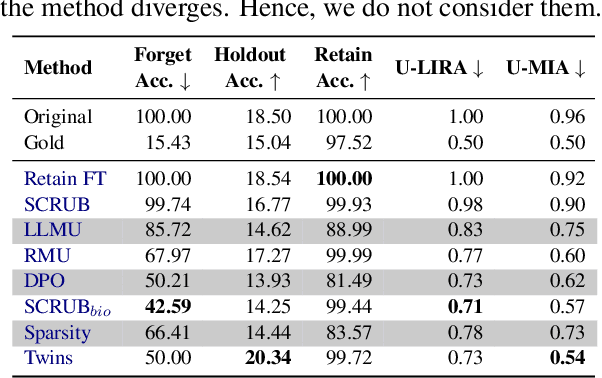
Abstract:Machine Unlearning (MU) is critical for enhancing privacy and security in deep learning models, particularly in large multimodal language models (MLLMs), by removing specific private or hazardous information. While MU has made significant progress in textual and visual modalities, multimodal unlearning (MMU) remains significantly underexplored, partially due to the absence of a suitable open-source benchmark. To address this, we introduce CLEAR, a new benchmark designed to evaluate MMU methods. CLEAR contains 200 fictitious individuals and 3,700 images linked with corresponding question-answer pairs, enabling a thorough evaluation across modalities. We assess 10 MU methods, adapting them for MMU, and highlight new challenges specific to multimodal forgetting. We also demonstrate that simple $\ell_1$ regularization on LoRA weights significantly mitigates catastrophic forgetting, preserving model performance on retained data. The dataset is available at https://huggingface.co/datasets/therem/CLEAR
Guide-and-Rescale: Self-Guidance Mechanism for Effective Tuning-Free Real Image Editing
Sep 02, 2024



Abstract:Despite recent advances in large-scale text-to-image generative models, manipulating real images with these models remains a challenging problem. The main limitations of existing editing methods are that they either fail to perform with consistent quality on a wide range of image edits or require time-consuming hyperparameter tuning or fine-tuning of the diffusion model to preserve the image-specific appearance of the input image. We propose a novel approach that is built upon a modified diffusion sampling process via the guidance mechanism. In this work, we explore the self-guidance technique to preserve the overall structure of the input image and its local regions appearance that should not be edited. In particular, we explicitly introduce layout-preserving energy functions that are aimed to save local and global structures of the source image. Additionally, we propose a noise rescaling mechanism that allows to preserve noise distribution by balancing the norms of classifier-free guidance and our proposed guiders during generation. Such a guiding approach does not require fine-tuning the diffusion model and exact inversion process. As a result, the proposed method provides a fast and high-quality editing mechanism. In our experiments, we show through human evaluation and quantitative analysis that the proposed method allows to produce desired editing which is more preferable by humans and also achieves a better trade-off between editing quality and preservation of the original image. Our code is available at https://github.com/FusionBrainLab/Guide-and-Rescale.
 Add to Chrome
Add to Chrome Add to Firefox
Add to Firefox Add to Edge
Add to Edge